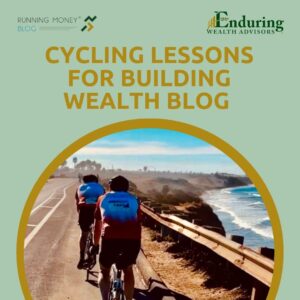 While grinding up 3,700 feet of California hills clipped into my road bike during this year’s Bike MS 150 Bay to Bay ride, e-bikes effortlessly buzzed past me while I consistently surged past my teammates on rental bikes using flat pedals. Like many of you reading this, I’m not really a cyclist. I’m a runner who cross-trains on a Peloton. However, every year I reserve the third weekend in October for this beautiful fundraising ride along the Southern California coast organized to fight Multiple Sclerosis.
While grinding up 3,700 feet of California hills clipped into my road bike during this year’s Bike MS 150 Bay to Bay ride, e-bikes effortlessly buzzed past me while I consistently surged past my teammates on rental bikes using flat pedals. Like many of you reading this, I’m not really a cyclist. I’m a runner who cross-trains on a Peloton. However, every year I reserve the third weekend in October for this beautiful fundraising ride along the Southern California coast organized to fight Multiple Sclerosis.
Believe it or not, it got me thinking about differing approaches to building wealth.
On the flat roads I was comfortable pedaling along with the group, enjoying both the company and the scenery. As we began climbing, however, our group broke into three distinct sections. Those of us with clip-in pedals began to pull ahead of the rentals, only to have the e-bikes engage their motors and wave politely as they passed by on our left.
To be sure, the flat peddlers exerted at least as much energy, it’s just that I was more efficient turning that effort into motion. They lost up to a tenth of their energy as their feet slipped slightly at the top and bottom of each rotation of the cranks.
Watch Out for Wasted Wealth
Which brings me to the first wealth building lesson:
You can save a lot of money and still fall behind your goals if you consistently lose or waste a tenth of your potential. We’re not just talking about taking too little risk in your long-run investments. We’re talking about things like carrying a monthly credit card balance, tapping retirement accounts or home equity for short-term spending, and missing out on tax favored investment choices.
Hidden Costs of Lifestyle Choices
Sarah, a 32-year-old designer, just landed a new position with base pay and bonus of $150,000. Living in Orange County, Sarah now takes home approximately $8,000 monthly ($96,000 annually) after taxes and benefits. She upgrades her lifestyle accordingly: new apartment ($2,800/month), car lease ($650/month), and a spending pattern that keeps her credit card balance around $8,000.
Sarah saves $1,000 monthly in her 401(k), plus another $500 in a Roth IRA. She’s putting away 12% of her gross income. With the 4% company match, she’s accumulating $24,000 per year in retirement accounts.
But here’s where the efficiency loss creeps in. That $8,000 credit card balance at 24% APR costs her $1,920 annually in interest ($160 monthly). Last year, rather than canceling her existing vacation plans, she borrowed $5,000 from her 401(k) to attend a friend’s destination wedding. The after-tax loan repayments effectively reduced her 401(k) contributions by $100 monthly for five years.
These costs reduce her wealth-building by about $260 monthly, or about 12% of the $24,000 she thinks she’s doing. If she doesn’t address these mistakes they compound dramatically. By the time she reaches full retirement age (FRA) at 67, she’ll have squandered over $600,000.
Business Building Profits the Owner
Those e-bikes that buzzed past me?
That’s a very different ride. The bikes are heavier, and the tires are fatter, absorbing a lot of road vibration. They’re all “step-through” frames, meaning the rider doesn’t have to lift one leg over the seat to get on and off. They have kick stands; at the rest areas they can park them pretty much anywhere. And they can open the throttle and motor up the steepest and longest hills.
But there are limits to their capabilities, too. Riders need to manage their power consumption. Excessive reliance on the battery runs the risk of draining it before reaching the destination. Sure, they still have pedals, but remember those heavy frames and fat tires? Without motor assistance, the cyclist works harder than even the flat peddlers.
Taking Worthwhile Risks
Sarah’s twin brother Abe also earns about $150,000. As a self-employed technology implementation specialist, he is constantly working to manage his cash flow. He’s structured his business to take advantage of Sub-S tax status, using a Solo-K retirement plan and tax-efficient funds for after tax investments to maintain liquidity for the lean times in his business.
Abe’s lifestyle differs significantly from Sarah’s. He is “house poor” having purchased a home in suburban Riverside County that consumes over 40% of his reliable monthly cash flow. He still drives the first new car he bought 10 years ago and manages to live on about $7,000 monthly after allocating more than $40,000 into his Solo-K and paying about $22,000 in income and property taxes. He pays most of his expenses on credit cards but rarely carries a balance incurring interest payments.
Like the e-bikers, Abe is using powerful tools to build wealth, wisely leveraging debt to build home equity and the tax code to improve tax efficiency. Most importantly, he keeps his lifestyle comfortably within his expected cash flow.
At the end of the day, we all had similar issues. Sore, maybe cramped muscles needed attention. Good food filled our bellies. Nothing could soothe our saddle-sore bottoms. A good night sleep before the final 40-mile ride from Carlsbad to Liberty Station in San Diego, including the 2.7-mile climb up Torrey Pines and the many coastal vistas along the way.
Fast-forward 20 Years
Sarah and Abe are both 52, and the fundamentals haven’t changed—they both saved consistently and invested for growth, but their different approaches and lifestyle choices are beginning to show the effects of compounding.
Sarah’s never been able to accumulate much in after-tax investments; she always spends just a bit more than she brings home, relying on annual bonuses and tax refunds to pay down the balances. Yet, she’s confident that she’ll be able to retire as she’s accumulated over $1 million in her 401k and Roth accounts.
Abe has paid off his house, using a 30-year mortgage, but paying additional principal to reduce the term to 20 years. This strategy cost him a fractionally higher interest rate but gave him the flexibility to make additional payments when his business had it available. He’s also grown his Solo-K to nearly $2.25 million. But unlike Sarah, he now has over $2,000 monthly cash flow available, much of which he’ll use to accumulate less aggressive investments to provide more safety when he quits working.
Both siblings are doing well, by comparison to the average American, but there are a few key differences. Sarah accepted the 401k default investments, which tend to be more conservative than the investment choices Abe made inside his Solo-K. He averaged just one percent more than her, but that added almost 13% more money to his account over the past 20 years. The bigger differences came from Abe’s lower taxes on similar gross income, plus his more modest lifestyle, allowing him to invest about $14,000 (in addition to the extra $400 monthly to his mortgage) more every year representing nearly $700,000 of their differing retirement balances.
Wealthy Ways to Win
The difference isn’t the fundamentals—consistent saving and long-term investing—but in execution efficiency and lifestyle choices. Just like the bike ride, different equipment and different techniques, but everyone who kept working crossed the finish line.
Like the flat peddlers losing 10% of their power, money lost financing lifestyle choices is inefficient. The sooner Sarah corrects these problems, the faster she can accelerate her investments.
Abe, simply by embracing self-employment, took more risk than his sister, and he used a more aggressive mix of investments in his portfolio. But he mitigated those risks through careful planning and living below his means. While higher risk does not guarantee higher returns, it is generally accepted that there is a correlation between risk and returns.
The important message is that success and the tools for achieving it are individual. Abe has more money, but Sarah is happy with her more flexible lifestyle choices. Both prioritized continual investing and used the available tools to get into position for the next phase their lives.
If you’re moved to support the National Multiple Sclerosis Society and their efforts to get to a world free of this neurological disease, donations accepted through 12/31/25 at:
Research and development of this article included the use of artificial intelligence tools.
